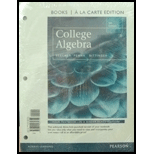
Concept explainers
Determine the leading term, the leading coefficient, and the degree of the polynomial. Then classify the polynomial as constant, linear, quadratic, cubic, or quartic.
1.
To find:
The leading term, the leading coefficient, the degree and the type of given polynomial
Answer to Problem 1CT
Solution:
The leading term is
Explanation of Solution
Given:
The given polynomial is
Concept:
(a) The leading term is the first term of a polynomial arranged in descending order of their powers.
(b) The leading coefficient is the coefficient of leading term.
(c) The degree is the highest power of a polynomial.
(d) The type of a polynomial is defined by its degree.
1 A polynomial with degree zero is the constant polynomial function.
2 A polynomial with degree one is the linear polynomial function.
3 A polynomial with degree two is the quadratic polynomial function.
4 A polynomial with degree three is the cubic polynomial function.
5 A polynomial with degree four is the quartic polynomial function.
The given polynomial
The first term of the polynomial is
The coefficient of the leading term is
The leading term has the highest power of 4. So, the degree of the polynomial is 4.
The degree of the polynomial is 4. So, the polynomial is a quartic polynomial.
Want to see more full solutions like this?
Chapter 4 Solutions
College Algebra, Books a la Carte Edition plus MyLab Math with Pearson eText, Access Card Package (5th Edition)
Additional Math Textbook Solutions
Calculus: Early Transcendentals (2nd Edition)
College Algebra (7th Edition)
Pre-Algebra Student Edition
Elementary Statistics: Picturing the World (7th Edition)
Algebra and Trigonometry (6th Edition)
- Solve questions by Course Name (Ordinary Differential Equations II 2)arrow_forwardplease Solve questions by Course Name( Ordinary Differential Equations II 2)arrow_forwardInThe Northern Lights are bright flashes of colored light between 50 and 200 miles above Earth. Suppose a flash occurs 150 miles above Earth. What is the measure of arc BD, the portion of Earth from which the flash is visible? (Earth’s radius is approximately 4000 miles.)arrow_forward
- e). n! (n - 1)!arrow_forwardSuppose you flip a fair two-sided coin four times and record the result. a). List the sample space of this experiment. That is, list all possible outcomes that could occur when flipping a fair two-sided coin four total times. Assume the two sides of the coin are Heads (H) and Tails (T).arrow_forwarde). n! (n - 1)!arrow_forward
- Evaluate the following expression and show your work to support your calculations. a). 6! b). 4! 3!0! 7! c). 5!2! d). 5!2! e). n! (n - 1)!arrow_forwardAmy and Samiha have a hat that contains two playing cards, one ace and one king. They are playing a game where they randomly pick a card out of the hat four times, with replacement. Amy thinks that the probability of getting exactly two aces in four picks is equal to the probability of not getting exactly two aces in four picks. Samiha disagrees. She thinks that the probability of not getting exactly two aces is greater. The sample space of possible outcomes is listed below. A represents an ace, and K represents a king. Who is correct?arrow_forwardConsider the exponential function f(x) = 12x. Complete the sentences about the key features of the graph. The domain is all real numbers. The range is y> 0. The equation of the asymptote is y = 0 The y-intercept is 1arrow_forward
 Algebra: Structure And Method, Book 1AlgebraISBN:9780395977224Author:Richard G. Brown, Mary P. Dolciani, Robert H. Sorgenfrey, William L. ColePublisher:McDougal Littell
Algebra: Structure And Method, Book 1AlgebraISBN:9780395977224Author:Richard G. Brown, Mary P. Dolciani, Robert H. Sorgenfrey, William L. ColePublisher:McDougal Littell College Algebra (MindTap Course List)AlgebraISBN:9781305652231Author:R. David Gustafson, Jeff HughesPublisher:Cengage Learning
College Algebra (MindTap Course List)AlgebraISBN:9781305652231Author:R. David Gustafson, Jeff HughesPublisher:Cengage Learning
- Algebra & Trigonometry with Analytic GeometryAlgebraISBN:9781133382119Author:SwokowskiPublisher:Cengage
 Trigonometry (MindTap Course List)TrigonometryISBN:9781337278461Author:Ron LarsonPublisher:Cengage Learning
Trigonometry (MindTap Course List)TrigonometryISBN:9781337278461Author:Ron LarsonPublisher:Cengage Learning





